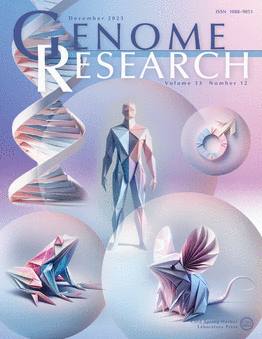种间系统生物学将细菌代谢途径与线虫基因表达、趋化行为和生存联系起来
IF 5.5
2区 生物学
Q1 BIOCHEMISTRY & MOLECULAR BIOLOGY
引用次数: 0
摘要
所有动物都与复杂的微生物群落密切相关,但研究单个细菌的影响仍然具有挑战性。细菌取食线虫是研究宿主微生物相互作用的强大系统,因为蠕虫可以在单氧培养物上生长。在这里,我们提出了三种不同类型的资源,这些资源可能有助于未来研究太平洋Pristionchus线虫以及其他生物的跨物种相互作用。首先,通过对84种pristionchus相关细菌的基因组测序,我们建立了研究宿主微生物相互作用的基因组基础,并证明了其在确定细菌中影响趋化行为和线虫存活的候选途径方面的实用性。其次,我们在38种细菌饲料中生成了太平洋p.a ificus线虫的转录组,并表征了60个对环境微生物群有不同反应的共表达模块。第三,我们通过预测超过2800种代谢相互作用的全球图谱,将微生物基因组和宿主转录组数据联系起来。这些相互作用代表了细菌代谢潜能的变化与线虫中共表达模块的差异转录组反应之间的统计关联。相互作用组的分析确定了几个肠道模块作为对不同微生物群的主要反应层,并揭示了许多广泛保守的代谢相互作用。总之,我们的研究为未来太平洋p.p . pacificus的机制研究建立了一个多组学框架,也可以在概念上转移并在其他生物中重新实施,以研究宿主微生物相互作用组的进化。本文章由计算机程序翻译,如有差异,请以英文原文为准。
Interspecies systems biology links bacterial metabolic pathways to nematode gene expression, chemotaxis behavior, and survival
All animals live in tight association with complex microbial communities, yet studying the effects of individual bacteria remains challenging. Bacterial feeding nematodes are powerful systems to study host microbe interactions as worms can be grown on monoxenic cultures. Here, we present three different types of resources that may assist future research of cross-species interactions in the nematode Pristionchus pacificus, but also in other organisms. First, by sequencing the genomes of 84 Pristionchus-associated bacteria, we establish a genomic basis to study host microbe interactions and we demonstrate its utility to identify candidate pathways in the bacteria affecting chemotaxis behavior and survival in the nematodes. Second, we generated nematode transcriptomes of P. pacificus nematodes on 38 bacterial diets and characterized 60 coexpression modules with differential responses to environmental microbiota. Third, we link the microbial genome and host transcriptome data by predicting a global map of more than 2,800 metabolic interactions. These interactions represent statistical associations between variation in bacterial metabolic potential and differential transcriptomic responses of coexpression modules in the nematode. Analysis of the interactome identifies several intestinal modules as the primary response layer to diverse microbiota and reveals a number of broadly conserved metabolic interactions. In summary, our study establishes a multiomic framework for future mechanistic studies in P. pacificus and may also be conceptually transferred and reimplemented in other organisms in order to investigate the evolution of the host microbe interactome.
求助全文
通过发布文献求助,成功后即可免费获取论文全文。
去求助
来源期刊

Genome research
生物-生化与分子生物学
CiteScore
12.40
自引率
1.40%
发文量
140
审稿时长
6 months
期刊介绍:
Launched in 1995, Genome Research is an international, continuously published, peer-reviewed journal that focuses on research that provides novel insights into the genome biology of all organisms, including advances in genomic medicine.
Among the topics considered by the journal are genome structure and function, comparative genomics, molecular evolution, genome-scale quantitative and population genetics, proteomics, epigenomics, and systems biology. The journal also features exciting gene discoveries and reports of cutting-edge computational biology and high-throughput methodologies.
New data in these areas are published as research papers, or methods and resource reports that provide novel information on technologies or tools that will be of interest to a broad readership. Complete data sets are presented electronically on the journal''s web site where appropriate. The journal also provides Reviews, Perspectives, and Insight/Outlook articles, which present commentary on the latest advances published both here and elsewhere, placing such progress in its broader biological context.
 求助内容:
求助内容: 应助结果提醒方式:
应助结果提醒方式:


